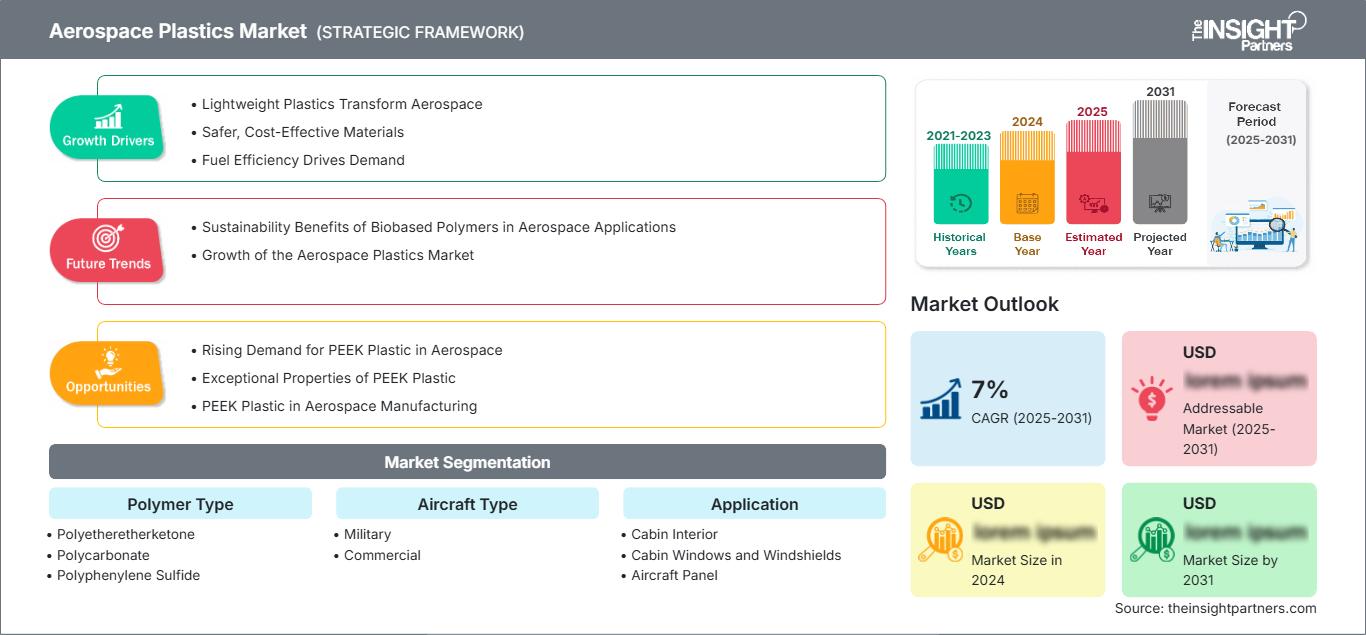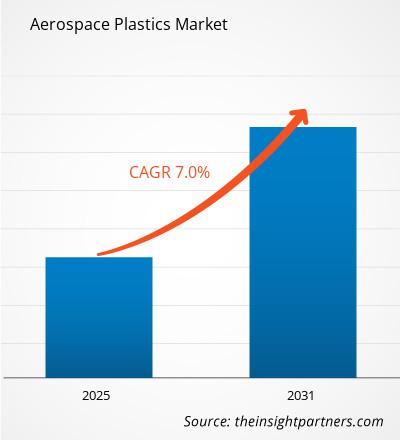Le marché des plastiques pour l'aérospatiale devrait enregistrer un TCAC de 7 % entre 2025 et 2031, avec une taille de marché passant de XX millions de dollars américains en 2024 à XX millions de dollars américains d'ici 2031.
Le rapport sur le marché des plastiques pour l'aérospatiale est segmenté par type de polymère (polyétheréthercétone, polycarbonate, sulfure de polyphénylène, polyétherimide, polyéthersulfone, polyméthacrylate de méthyle, etc.). Le rapport présente également une analyse basée sur le type d'avion (militaire, commercial, etc.). Le rapport est segmenté en fonction de l'application (intérieur de cabine, fenêtres et pare-brise de cabine, panneaux d'avion, etc.). L'analyse mondiale est ensuite ventilée au niveau régional et par principaux pays. La taille et les prévisions du marché aux niveaux mondial, régional et national pour tous les segments de marché clés sont couvertes dans le cadre du périmètre. Français Le rapport offre la valeur en USD pour l'analyse, les segments, les régions et les pays ci-dessus.
Objectif du rapport
Le rapport sur le marché des plastiques aérospatiaux de The Insight Partners vise à décrire le paysage actuel et la croissance future, les principaux facteurs moteurs, les défis et les opportunités. Cela fournira des informations à diverses parties prenantes commerciales, telles que :
- Fournisseurs de technologies/Fabricants : Pour comprendre l'évolution de la dynamique du marché et connaître les opportunités de croissance potentielles, leur permettant de prendre des décisions stratégiques éclairées.
- Investisseurs : Pour réaliser une analyse complète des tendances concernant le taux de croissance du marché, les projections financières du marché et les opportunités qui existent tout au long de la chaîne de valeur.
- Organismes de réglementation : Pour réglementer les politiques et les activités de police sur le marché afin de minimiser les abus, de préserver la confiance des investisseurs et de maintenir l'intégrité et la stabilité du marché.
Segmentation du marché des plastiques pour l'aérospatiale Type de polymère
- Polyétheréthercétone
- Polycarbonate
- Polysulfure de phénylène
- Polyétherimide
- Polyéthersulfone
- Polyméthacrylate de méthyle
Type d'avion
- Militaire
- Commercial
Application
- Intérieur de cabine
- Hublots et pare-brise de cabine
- Panneau d'avion
Géographie
- Amérique du Nord
- Europe
- Asie-Pacifique
- Amérique du Sud et centrale
- Moyen-Orient et Afrique
Vous bénéficierez d’une personnalisation sur n’importe quel rapport - gratuitement - y compris des parties de ce rapport, ou une analyse au niveau du pays, un pack de données Excel, ainsi que de profiter d’offres exceptionnelles et de réductions pour les start-ups et les universités
Marché des plastiques pour l'aérospatiale: Perspectives stratégiques

-
Obtenez les principales tendances clés du marché de ce rapport.Cet échantillon GRATUIT comprendra une analyse de données, allant des tendances du marché aux estimations et prévisions.
Moteurs de croissance du marché des plastiques pour l'aéronautique
- Les plastiques légers transforment l'aéronautique : la demande croissante de matériaux légers dans l'industrie aéronautique stimule la croissance du marché des plastiques pour l'aéronautique. Il existe une demande croissante de matériaux légers et durables, car les avionneurs doivent fabriquer des composants et des pièces plus légers afin de maximiser l'efficacité énergétique.
- Matériaux plus sûrs et rentables : le secteur aéronautique s'intéresse également à la sécurité et à la rentabilité que peuvent offrir les matériaux légers, ce qui accroît encore l'adoption de matériaux légers, comme le plastique. Le besoin croissant de matériaux légers pour la fabrication de composants et de pièces aéronautiques a considérablement accru la demande de plastiques.
- L'efficacité énergétique stimule la demande : les avionneurs s'efforcent de développer d'énormes structures thermoplastiques primaires pour les jets d'affaires et les avions commerciaux. Les matériaux tels que les composites et les plastiques sont nettement plus légers que l'acier, le laiton, les alliages, le fer, etc. L'utilisation de ces matériaux permet aux fabricants de réduire le poids des pièces d'avion, facilitant ainsi la réduction des coûts de carburant. De plus, l'adoption des plastiques dans les applications cabine est motivée par des avantages en termes de légèreté, de coût et de sécurité. Les plastiques peuvent offrir une meilleure isolation et une meilleure protection pour divers composants à l'intérieur de l'avion, ce qui contribue à la sécurité et à l'efficacité globales.
Tendances futures du marché des plastiques pour l'aérospatiale
- Avantages des polymères biosourcés en matière de durabilité dans les applications aérospatiales : Les polymères biosourcés offrent l'avantage distinctif de réduire la dépendance aux ressources en combustibles fossiles et de diminuer les émissions de gaz à effet de serre. Les matériaux bioplastiques sont utilisés dans les composants structurels et non structurels, les matériaux d'isolation thermique, les matériaux d'isolation acoustique, les composants de décoration intérieure, etc. Les deux matériaux bioplastiques les plus utilisés dans l'industrie aérospatiale sont les polymères renforcés de fibres de lin (FFRP) et les composites à base de mycélium.
- Croissance du marché des plastiques pour l'aérospatiale : De plus, avec une demande toujours croissante et une innovation continue, le marché des plastiques pour l'aérospatiale connaît une croissance fulgurante. L'industrie aérospatiale évolue vers la durabilité, et les bioplastiques constituent une solution grâce à l'utilisation de matériaux plus respectueux de l'environnement que les plastiques conventionnels. Les acteurs du marché se concentrent également sur l'investissement dans la recherche et le développement, ainsi que sur le développement et le lancement de produits nouveaux et innovants pour l'industrie aérospatiale.
Opportunités du marché des plastiques pour l'aérospatiale
- Demande croissante de plastique PEEK dans l'aérospatiale : La forte demande de plastique PEEK dans l'industrie aérospatiale devrait offrir des opportunités de croissance plus lucratives au cours de la période de prévision. Le plastique PEEK est essentiel à la conception aérospatiale moderne. Le PEEK est un thermoplastique technique dont le rapport résistance/poids et la résistance aux températures extrêmes et aux produits chimiques sont vraiment exceptionnels.
- Propriétés exceptionnelles du plastique PEEK : Trouver un plastique qui les aide à construire des avions plus légers et plus efficaces est une révolution pour les entreprises aérospatiales. Le plastique PEEK est considéré comme adapté à la conception aérospatiale, car il allie rigidité, ténacité et résistance thermique à des niveaux exceptionnellement élevés par rapport à tous les autres plastiques.
- Le plastique PEEK dans la fabrication aérospatiale : Le plastique PEEK est couramment utilisé dans la fabrication aérospatiale, car il permet de réduire le poids superflu tout en résistant aux températures extrêmes, à l'usure et à la corrosion. Cela a conduit les ingénieurs à l'utiliser comme alternative au métal pour optimiser les performances en termes de rendement énergétique, notamment dans la fabrication de moteurs et de composants structurels.
Aperçu régional du marché des plastiques pour l'aérospatiale
Les tendances régionales et les facteurs influençant le marché des plastiques pour l'aéronautique tout au long de la période de prévision ont été analysés en détail par les analystes de The Insight Partners. Cette section aborde également les segments et la géographie du marché des plastiques pour l'aéronautique en Amérique du Nord, en Europe, en Asie-Pacifique, au Moyen-Orient et en Afrique, ainsi qu'en Amérique du Sud et en Amérique centrale.
Portée du rapport sur le marché des plastiques pour l'aérospatiale
| Attribut de rapport | Détails |
|---|---|
| Taille du marché en 2024 | US$ XX million |
| Taille du marché par 2031 | US$ XX Million |
| TCAC mondial (2025 - 2031) | 7% |
| Données historiques | 2021-2023 |
| Période de prévision | 2025-2031 |
| Segments couverts |
By Type de polymère
|
| Régions et pays couverts |
Amérique du Nord
|
| Leaders du marché et profils d'entreprises clés |
|
Densité des acteurs du marché des plastiques pour l'aérospatiale : comprendre son impact sur la dynamique des entreprises
Le marché des plastiques pour l'aéronautique connaît une croissance rapide, portée par une demande croissante des utilisateurs finaux, due à des facteurs tels que l'évolution des préférences des consommateurs, les avancées technologiques et une meilleure connaissance des avantages du produit. Face à cette demande croissante, les entreprises élargissent leur offre, innovent pour répondre aux besoins des consommateurs et capitalisent sur les nouvelles tendances, ce qui alimente la croissance du marché.

- Obtenez le Marché des plastiques pour l'aérospatiale Aperçu des principaux acteurs clés
- Analyse historique (2 ans), année de base, prévision (7 ans) avec TCAC
- Analyse PEST et SWOT
- Taille du marché Valeur / Volume - Mondial, Régional, Pays
- Industrie et paysage concurrentiel
- Ensemble de données Excel
Rapports récents
Rapports connexes
Témoignages
Raison d'acheter
- Prise de décision éclairée
- Compréhension de la dynamique du marché
- Analyse concurrentielle
- Connaissances clients
- Prévisions de marché
- Atténuation des risques
- Planification stratégique
- Justification des investissements
- Identification des marchés émergents
- Amélioration des stratégies marketing
- Amélioration de l'efficacité opérationnelle
- Alignement sur les tendances réglementaires






















 Obtenez un échantillon gratuit pour - Marché des plastiques pour l'aérospatiale
Obtenez un échantillon gratuit pour - Marché des plastiques pour l'aérospatiale